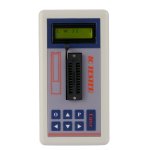Generally I have not gone for the notion of " IC Testers".
In many ways, I learnt this from my experiences going way back, repairing Tube radios & TV's. And the fact that tube testers and Transistor testers existed.
How does that remark relate to IC testers I wonder ?
Well, it was pretty obvious to those repairing defective apparatus that any component under suspicion was in fact better tested; "in the circuit is was running in".
In other words, "testers" which exposed the component to other operating conditions than it was used in, specifically input voltage ranges and output loading effects, were in fact not as good as testing the device in the environment of the equipment they are actually used in.
(The classic "tester disease" here is the CRT tester. There is no better test a CRT's performance than testing it in the TV or VDU it was designed to be in, and inspecting the beam focus, contrast and brightness. No CRT tester, that just gives the gun emission, can come anywhere close to a real world test. Yes "real World" sounds like a cliche from the 1980's where the most over used word was "supportive")
In other words, you don't need a tube tester , a transistor tester, or an IC tester for that matter. You simply check the device in its operating circuit with the scope and confirm that, in the case of a logic IC, obeys its logic table.
There are numerous examples out there:
Some ebay IC testers for example report the 7425 IC as defective when it is not, but report the 74LS20 as ok.
There are also IC testers on ebay, that report some 4116 DRAM IC's as defective, when they are not.
Yet, the vintage computers they are used in don't make these "errors of judgement".
One reason is that the designers of the vintage computers, spent a lot more time studying the data sheets for the IC's (specifically memory IC's) and their timing requirements, than the designers of the ebay IC testers that thought it would be a simple matter to code the test protocol into an Arduino. I call these errors; "The underestimated difficulty level effect"
But, I'm not trying to be a naysayer here, with regards to modern IC testers. These might have a better role screening for defective IC's in the IC recycling industry. Certainly, this is what happened to Tube testers.
I would suggest exercising caution, and instead, if you want to test common logic IC's, use your own Brain, get out their data sheet, power up your scope and check that the IC in its operating circuit is working correctly, or not, before jumping to conclusions that there is something wrong with the IC because some tester said there was.
Also, when I see stories and posts where people have a faulty computer; the repair methodology they use is to un-solder multiple IC's, test them on a tester, in the hope of finding a faulty one, I cringe. It shows no effort to understand how the circuit works, perform diagnostic tests on it, formulate a theory as to what has gone wrong, and then create a targeted repair. It is like letting a Chimpanzee do the repair. Mind you, as the old saying goes, if you sit one down at a Typewriter and wait long enough, you will get the entire works of Shakespeare.


